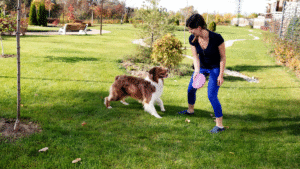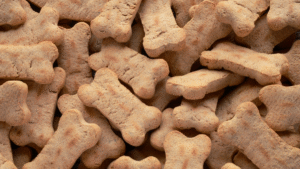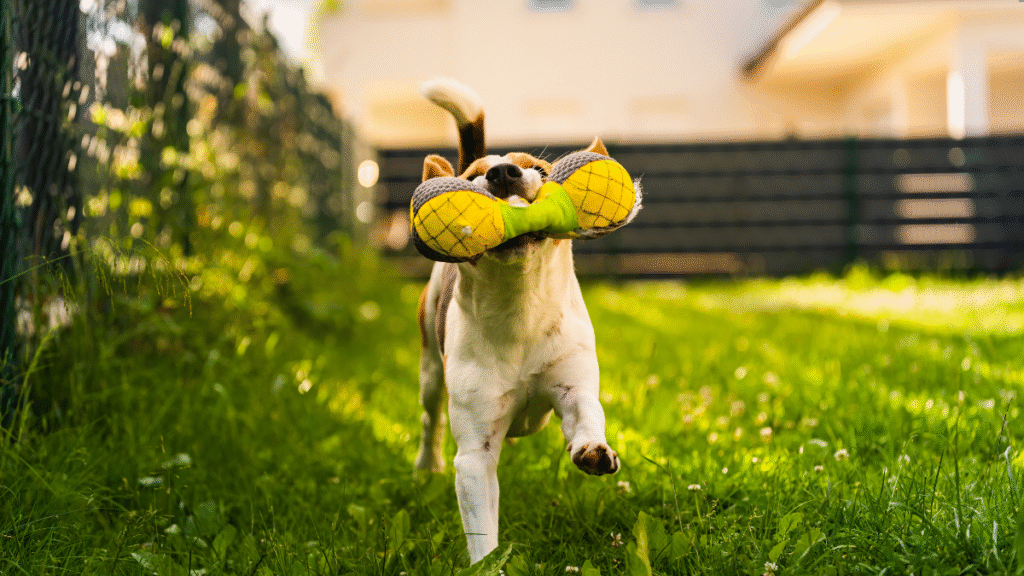Fetch is one of the most classic games you can play with your dog. It’s fun, interactive, and provides plenty of mental and physical exercise. But not every dog is a natural retriever.
Some pups will chase the ball with reckless enthusiasm but never bring it back, while others look at you as if you’re crazy for expecting them to chase a stick or flying disc.
If this sounds like your dog, don’t worry—any dog can learn to fetch with the right motivation, approach, and reinforcement.

Why Teaching Your Dog to Fetch Is Important
Playing fetch is one of the best forms of enrichment for dogs. It’s a great way to bond, provide physical exercise, and channel energy that might otherwise be spent chewing furniture or shredding your favorite slippers.
Fetch also helps improve obedience and impulse control. It reinforces commands like “drop it,” “come,” and “stay.” The game engages both body and mind, making it especially valuable for high-energy breeds like Border Collies, Retrievers, and Terriers.
The good news is that even dogs who aren’t “natural retrievers” can still learn to play fetch if you make the game motivating and rewarding.
Step 1: Pick the Right Toy
One of the biggest challenges owners face is using a toy their dog simply doesn’t like. Not all dogs are tennis-ball fanatics. Some prefer squeaky toys, rubber bones, or plush stuffed animals. If you want your dog to enjoy fetch, start with a toy they already love.
Tips for finding the right fetch toy:
-
Offer different textures and sizes. Try soft balls, hard rubber balls, bones, or small squeaky toys. Different breeds and personalities prefer different textures.
-
Experiment with scents and sounds. Some dogs respond better to squeaky toys or ones rubbed with treats for added scent appeal.
-
Use a favorite toy. If your dog already adores a specific toy, use that one instead of introducing something new.
If your dog isn’t interested in the toy, they won’t be motivated to chase it—so this step is crucial.
Step 2: Build Interest in the Toy
Before you can expect your dog to fetch, they need to find the toy exciting and worth pursuing. Use play and positive reinforcement to build value in the toy.
Ways to build toy interest:
-
Play keep-away. Move the toy around, wave it, and let your dog chase it while it’s in your hands.
-
Play tug-of-war. Tug games help your dog learn that the toy is something valuable and fun to hold onto.
-
Reward interaction. Praise and treat your dog for touching or grabbing the toy.
-
Add scent. Rub a treat or a bit of peanut butter on the toy to make it smell irresistible.
The goal is to make your dog think, “That toy is AWESOME!”

Step 3: Teach the “Take It” Command
Once your dog is interested in the toy, teach them to pick it up on command.
How to teach “take it”:
-
Hold the toy in front of your dog and say “take it.”
-
Reward any sniffing or mouthing of the toy with praise and a treat.
-
Gradually wait for more engagement—such as biting or picking up the toy—before rewarding.
-
Practice several times per day until your dog understands that “take it” means “pick up the toy.”
If your dog struggles, make the toy more appealing by rubbing it with a treat scent like peanut butter or chicken broth.
Step 4: Encourage Bringing It Back
This is the step most owners find tricky. Many dogs will grab the toy but won’t return it. Some run off to play by themselves, while others drop it halfway.
To teach your dog to bring the toy back:
-
Start indoors or in a small enclosed area. Smaller spaces make it easier for your dog to return to you.
-
Toss the toy a short distance—just a few feet—and say “fetch.”
-
Call your dog enthusiastically as they pick it up. Use a cheerful, high-pitched voice and open arms.
-
Reward the return. As soon as your dog comes back with the toy, praise and treat immediately.
-
Reward progress. If your dog drops the toy partway, praise them for coming even part of the way back.
You can also use two identical toys: when your dog picks up the first toy, show them the second one. They’ll likely drop the first toy to chase the second—rewarding the “drop” behavior naturally.

Step 5: Teach the “Drop It” Command
“Drop it” is essential for a smooth game of fetch. Your dog needs to release the toy willingly so the game can continue.
How to train “drop it”:
-
When your dog has the toy, say “drop it” and show them a treat.
-
As soon as they release the toy, reward and praise them.
-
Repeat several times until your dog learns that letting go of the toy earns a reward.
-
Over time, fade out the treats and reward with praise or another throw of the toy.
Step 6: Combine Everything into a Full Fetch Game
Once your dog understands each step, combine them into a full fetch routine.
How to play fetch:
-
Say “fetch” and toss the toy a short distance.
-
Encourage your dog to chase and grab it.
-
Call your dog back with enthusiasm.
-
Say “drop it” and reward when they do.
-
Throw the toy again to continue the game.
Start with short sessions—just a few minutes—and gradually increase the distance and duration as your dog gains confidence.
Step 7: Keep Games Positive and Fun
Fetch should always be enjoyable. If your dog seems tired, frustrated, or bored, end the session and try again later. Never punish your dog for ignoring you or running off with the toy. That can make fetch stressful and counterproductive.
Keep your tone upbeat and reward progress. End every session on a positive note so your dog looks forward to the next game.
If your dog seems bored, change the toy, add new sounds, or throw from different angles. Keeping the game varied maintains interest.

Common Problems and How to Solve Them
Problem 1: My dog won’t chase the toy.
Solution: Try a toy that moves or squeaks. Drag it on the ground or toss it only a few feet. Reward any attempt your dog makes to chase it.
Problem 2: My dog chases but won’t pick it up.
Solution: Revisit the “take it” command. Reward your dog for picking up the toy and make it smell appealing with a treat scent.
Problem 3: My dog runs off with the toy.
Solution: Don’t chase your dog—it turns into a game of keep-away. Instead, call them cheerfully and offer a trade with another toy or a treat.
Problem 4: My dog brings the toy back but won’t drop it.
Solution: Practice “drop it” separately until your dog releases objects consistently, then apply it during fetch sessions.
Beyond Exercise: The Mental Benefits of Fetch
Fetch isn’t just a physical workout—it’s also a powerful mental exercise. The sequence of chasing, picking up, returning, and dropping the toy engages your dog’s brain and improves focus and obedience.
For anxious or high-energy dogs, fetch can also be calming. The repetitive motion of chasing and returning releases tension and helps relieve stress.
Most importantly, fetch strengthens your bond. Every toss and return builds trust and communication between you and your dog.
Fun Variations on Fetch
Once your dog masters the basics, try different types of fetch to keep things exciting:
-
Water Fetch: Perfect for dogs that love swimming. Use a floating toy in a pool or shallow lake.
-
Hide-and-Seek Fetch: Hide the toy behind furniture or in another room and encourage your dog to find it.
-
Frisbee Fetch: Great for athletic dogs with good coordination. Use a soft flying disc instead of a ball.
-
Hill Fetch: Throw the toy up or down a gentle slope for extra exercise.
Conclusion
Teaching your dog to fetch—even if they aren’t a natural retriever—doesn’t have to be complicated. The key is understanding what motivates your dog and making the toy exciting. Break the process into small, manageable steps, and be patient and consistent.
Not every dog will become a perfect retriever, but that’s okay. What matters most is that you’re bonding, having fun, and giving your dog meaningful mental and physical exercise. With the right approach, any dog can learn to enjoy this classic, rewarding game.
- 5 Cheap Alternatives To Dog Training Equipment - November 12, 2025
- Homemade Calming Spray To Help Dogs During Training - November 12, 2025
- 7 DIY Dog Training Tools You Can Make From Household Items - November 12, 2025
